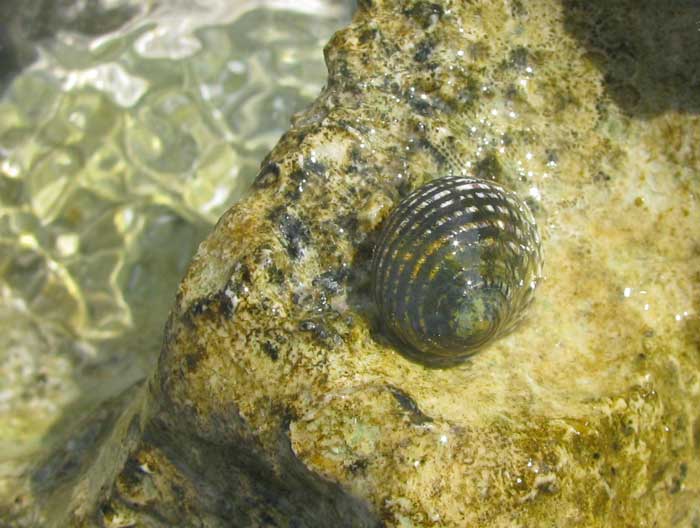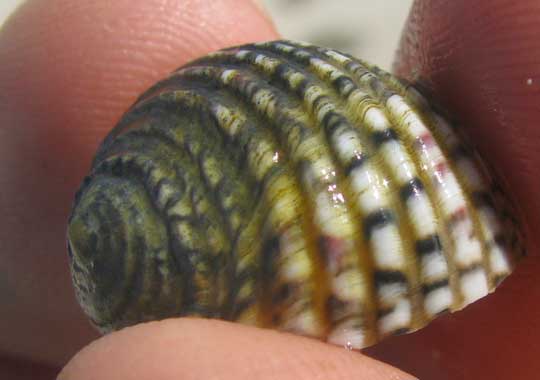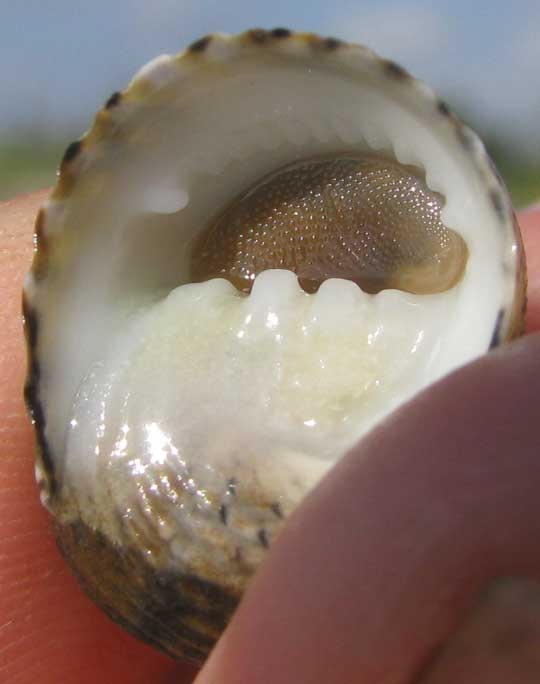Excerpts from Jim Conrad's
Naturalist Newsletter

from the May 8, 2011 Newsletter issued from Mayan Beach Garden Inn 20 kms north of Mahahual; Caribbean coastal beach and mangroves, ~N18.89°, ~W87.64°, Quintana Roo state, MÉXICO
SNAIL-LIKE ON A ROCK
I waded among half-emerged rocks at a rocky point just up the beach, not knowing at all what to expect. The first living creature spotted was a thimble-size, snail-like critter stuck to an algae-encrusted limestone rock that most of the time was submerged as waves rolled over it, but sometimes, between waves, emerged above the water, as shown above.
The shell was easy to pry from the rock. You can see his shell ornamented with purple-banded ridges below:

Tilting the shell, I found the animal protectively retracted into his shell, as shown below:

Obviously this is a mollusk -- an animal mantled with a single shell carried above a muscular foot, the animal's internal organs protected by the shell. Snails are the best known mollusks.
Happily, Bea in Canada, who in the past has volunteered to identify our insects, now has offered to ID our "seashells." She hadn't had my above pictures for long before she wrote back that our rock-living creature was a Four-tooth Nerite, NERITA VERSICOLOR, and she even said that IDing it had been easy. Here's how she said she did it:
"I entered some search words in Google, most likely something like 'seashells Gulf of Mexico' which brought up lots of websites. I started checking out a few until I came across this one called Holman Shell Collection: http://research.fit.edu/shells/complete.php I started clicking on the different groups of shells starting at the beginning of the list, skipping the ones I was familiar with and knew that it wasn't, for example a conch. I would check out just one in each group. Once I clicked on a Limpet for example, I knew it wasn't any of the other Limpets, so I would try the next group. I kept going until I came across the Nerites and said AHA!!"
Having the name, now I could search for information on the Internet. There I learned that Four-tooth Nerites move up and down the shore in step with the tide's high water level, and that they're particularly resistant to periods of heat and desiccation. Nerites seem to occur in nearly all the world's tropical and subtropical seas, except the eastern Pacific.
We ran into another nerite species, Neritina virginea, back in 2006 at Río Lagartos on the Yucatán's northern coast. You can some of the many variations of that one at www.backyardnature.net/yucatan/nerites.htm.
Our present Nerita versicolor, as its species name versicolor implies, also is very variable. So I'm getting the impression that nerites are unusually colorful, commonly occurring, aquatic, snail-like creatures to be identified not by color and pattern but rather by structure.